by Jenny Rose | Nov 25, 2023 | A Flourishing Woman, Body
In the last few months I have noticed a pattern as I teach private swim lessons.
It first caught my attention over the summer as I worked with a six-year-old in her home pool. She and I have worked together for some years. We have a good relationship built on trust and affection. She’s strong and big for her age, and she’s a tiger, assertive, competitive, stubborn, determined. She’s focused on progression through Red Cross Learn-to-Swim levels. She’s less interested in the skill-building than the card proclaiming her a Level ___ swimmer, and she wants the card now.
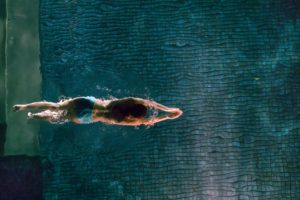
Photo by Chris Kristiansen on Unsplash
I started out her summer lessons the way I always do, with a review of the skills I knew she had already mastered. Then we began working on next-level skills. Except things fell apart. I began to feel frustrated. Her behavior, instead of sunny and eager (she was always waiting in the water for me until this), became oppositional. She stopped laughing with me. She stopped looking me in the eye. She stopped cooperating. She wouldn’t follow directions, she had to be coaxed into the water, and suddenly it wasn’t fun for either of us.
Her mom and I were puzzled. We agreed to take a couple of weeks off and regroup. My little student seemed relieved. During that time I thought about things and my student had some talks with her parents as we all tried to figure out what was wrong. Young children often lack the language to communicate their difficulties. Adults need to decode the behavior and provide the language.
I threw away my lesson plans for the next level and worked on games incorporating skills she already had. I made sure she knew our next lesson would be games. When I got to her house, she was able to tell me, with her mom’s support, that she didn’t want to learn some of the new skills I was presenting.
I suddenly recalled I was working with a six-year-old. Big, strong, determined, yes. But six years old! The level she and I had reached is typically a skill set nine to eleven-year-olds are working on.
Too much, too fast. Her competitiveness and determination had outstripped her physical and developmental ability, and in my delight in teaching and sharing my love for swimming, I simply forgot what was age-appropriate.
So, we spent the summer playing games and giggling. We practiced all the skills she already had, and we worked on some new ones, too, but she didn’t know that because they were games. If she didn’t like the game, we stopped immediately and did something else. She made up some games, too. We had a lot of fun. She waited in the water for me and pouted when our lessons ended. We were back in business.
I spoke privately with her mom and we agreed to slow down. This little girl needs time. Time to grow. Time to develop. Time to play and simply enjoy the water. Next summer she’ll be seven. If I work with her again, I’ll pay attention. She may be ready for next-level skills. She may not. But this time I’ll adjust more quickly, and she’ll have better language skills, too.
I have been observing this pattern during the autumn months as I teach. Sometimes kids want to learn more but we don’t have a lot more to teach them. Sometimes they want to learn more, or their parents want them to learn more, but they’re simply not ready physically or developmentally. An activity that used to be fun and easy starts to be stressful. Parents are frustrated. I’m not having fun. Children are uncooperative.
I’ve been thinking about time lately because in October I caught COVID for the first time and I’ve been sick ever since. I took good care of myself during COVID, in part because I was too sick to fight it. As I began to feel better, I slowly started exercising again. I didn’t want to slide backwards or develop a secondary infection. I was worried about weight loss and weakness, as well as my fatigue and lack of endurance. I gradually began walking to work again, and doing a mile at a time on the elliptical. I even got back in the pool and did an easy half a mile instead of my usual ¾ of a mile with intermittent sprinting.
I was just beginning to feel better when I got sick again. Not with COVID and not as sick, but I filled up with congestion and started to cough.

Photo by Travis Bozeman on Unsplash
So, it’s been doctor visits. More nasal swab testing. Masks at work. Shortened shifts. Teaching lessons from the deck rather than in the water. No gym. No swimming. No walking to work.
The doctor keeps saying rest. My friends keep saying rest. I am resting, I swear it! I don’t have a lot of choice. If I do housework for an hour I’m worn out. I can rest, but sleep has been hard to come by because when I lie down I start to cough and nothing really stops it. The nights have been hard. And haunted.
I’ve been dreaming about my mother, who died in August. Bad dreams, where she’s in trouble and I’m trying to rescue her. Often we’re in water, which is ridiculous because Mom hated the water. Often we’re in the dark, but I can hear her end-stage breathing and death rattle and I grope through the dream, trying to find her. Sometimes I find her and get my arms around her, but then I wake up. In fact, Mom hated to be touched and I never held her the way I do in my dreams. Only in her deep dementia would she tolerate touch. The dreams hurt me with their promise of loving contact that never happened and now never will happen. I doze in my recliner and wake up weeping.
I want to move, to be at work, to go out and rake leaves, to scrub the kitchen floor. Something. Anything. I trail into the kitchen, make another cup of tea, have another half cup of chicken soup, read a few pages, write a bit. I get in the car to go to work instead of walking (everyone at works frowns at me when they find out I walked), and I’m resentful. I want my life back. I want my strong, fit body back. I want my energy back. I want it back NOW.
And, clearly, I need time. I don’t want it … but I need it. I suppose it doesn’t much matter if my experience is post-COVID, or post-whatever-this-last-virus was or grief or trauma or just getting old (!). Whatever it is, I am not in charge, and my stubbornness and determination are presently more than my physical and perhaps emotional reality can live up to.
Time is enigmatic, isn’t it? We say time heals all wounds. Does it, or does it just give us a chance to process our wounds, to clean them out, breathe on them, bind them up and learn to live with them? How can I help myself? What am I supposed to be doing with all this unwanted time? I think of my little swimmer. She doesn’t need to do anything. She’s perfect. She simply needs to give herself some time to grow. That’s it. Time does the work. Our job is to allow it to do the work.
This is unsatisfying. I’ve read that rest is productive, which makes me mad. It cannot be true. I can’t remember ever feeling loved, valued, or wanted because I rested well. Quite the reverse. (On the other hand, when has unceasing production ever worked to buy love, value, or a sense of being wanted? Never.) I have a feeling Time doesn’t need me to do anything, at least not anything I’m not already doing. Another cup of tea. All the calories I can take in. Rest. Tears. Dreams. Writing. Reading and dozing on the couch with the cats.

Photo by Benjamin Combs on Unsplash
Time.
I worked two days Thanksgiving week before having five days off. My physical upper respiratory symptoms are certainly better. Normal sleep patterns are returning. Yet a dragging fatigue and bewildered feeling remain. “It’s detox,” my massage therapist says. “It’s transformation,” the wisest, deepest part of me says. “It’s rebirth,” my Tarot cards say.
It takes time. Everyone agrees on that one.
I remember my little swim student, outraged tears in her eyes. “I’m still a Level ___, right? You won’t take away my Level ___?”
“No, sweetie. You haven’t lost anything. It’s all still yours. You’re just not quite ready to go on to the next level. You need some time …”
I hugged her and gave her a kiss, told her I’d see her again next summer if she wanted lessons. She believed me, reluctantly. She’s in a dance class this winter. That will distract her, I hope.
Now I need to put my arms around myself. My life is not passing me by. I’ll exercise again. I’ll put the weight back on. I’ll get strong, sleep well, stop coughing.
I just need some more time.
Questions:
- Do you think rest is productive? In what way(s)?
- Do you think of time as an ally or an adversary?
- Do you think time actually heals, or does it just help us come to terms with what is?
- What does rest mean to you?
Leave a comment below!
To read my fiction, serially published free every week, go here: 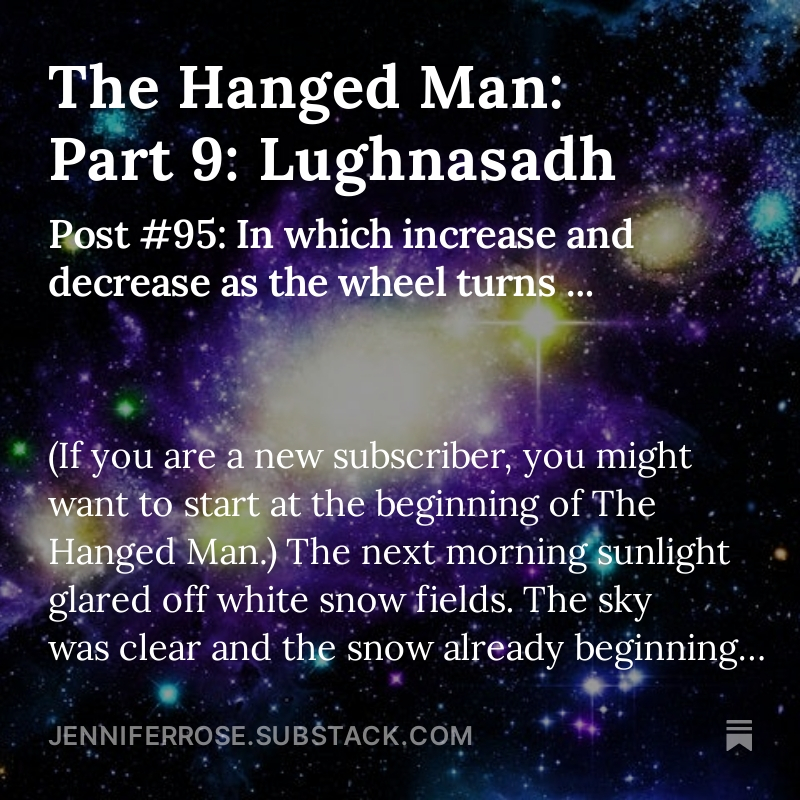
by Jenny Rose | Oct 21, 2023 | A Flourishing Woman, Body
I came down with COVID this week. It’s the first time I’ve had it, for which I’m thankful, as I’ve been diligent about vaccinations and I’m sure they are mitigating the virus. Three weeks ago I received the latest vaccination, in fact. (And no, I don’t think that’s why I got COVID!) 
In our current world a positive COVID test is an iron-bound, all-purpose excuse for downing tools, stepping away, and spending some quiet time in solitude. So here I am, on the bench (or in my case, a comfy couch) instead of making my way through my usual work week and routines.
I haven’t been afraid of winding up in the hospital on a ventilator. I’m not especially high risk and in very good health. I’ve been resigned, more than anything else. Resigned that I unknowingly exposed my friends and coworkers before I knew what was happening. Resigned that this is a different viral experience than I’ve ever had before. Resigned that someone else taught my group swimming lessons and enjoyed the kids. Resigned to the fact that now we all have to mask for a time at work.
I’ve been miserable with fever, aches, congestion, and difficulty breathing. The physical symptoms are easing; however, I have entirely lost both taste and smell, perhaps the most distressing symptom of all, in part because it’s so different. Yesterday I ventured out for a walk.
It was breezy and grey with rain moving in, the air warm and soft. I took a short neighborhood walk, enjoying being outside and moving, but struggling with shortness of breath, disoriented by my inability to smell the rain coming and the crisping leaves. I feel cut off from my greatest source of solace, the natural world. I will continue to walk every day because my body needs it, but my joy in being outside is painfully diminished.
When I completed my test route, I felt too tired to do more. I came home and discovered I’d been gone less than 10 minutes.
At times like this I bless my passion for reading. I’ve had eye inflammation and itching with this virus; a symptom I’ve never had before. It worsens as my fever increases and makes looking at a screen or watching TV miserable, as well as sitting in any kind of sunlight. However, I can turn on a lamp and read until I doze, then wake and read some more. This passes the time, keeps me quiet, and distracts me from my present experience.

Photo by Joanna Kosinska on Unsplash
This morning I walked again in a light rain. It’s been a dull-colored fall here. Some leaves are finally starting to turn; other trees are mostly bare already. This time I was ready for scent blindness. I turned away from what I couldn’t do and feasted my eyes on the rich colors of fall-blooming flowers and the leaves. A humid breeze fanned my cheek. I focused on breathing, filling my weary lungs with the fresh, damp air, exhaling as well as I could through my nose. I paid attention to what I heard: crows squabbling, an occasional passing car, a barking dog, the subtle background sound of the rain. I walked a longer distance than yesterday.
I haven’t run a fever from more than 24 hours and my throat feels normal again. Progress, although my heart thumps uncomfortably when I’m up and doing things and I have the lingering feeling I’m not getting quite enough air. Still, symptoms are clearly abating.
Benches are not comfortable, for the most part. No back support. Hard under the ass. Sitting on the sidelines watching others live their lives when we can’t participate much in ours is discouraging. So much of my daily centering, comfort, and self-care are bound up with scent. I could not have anticipated how devastated I feel without the simple ability to smell and taste. My scented fall candles, usually a daily pleasure, sit unlit. Tea might as well be plain hot water. Food is absolutely tasteless. I can’t smell when the cat boxes need to be emptied. Cleaning doesn’t smell like cleaning. Fresh air doesn’t smell fresh. Taking a shower, using soap and lotion and putting on clean clothes, is joyless. Eating is a chore.
Yet still there is reading, and writing. I’m washing my sheets. I’ve aired out my room and waved a smudge stick around. I’ve washed the breakfast dishes. The cats are snuggled up with me in my chair. The rain comes down. Another cup of tea cools at my elbow. I picked up a scarlet leaf while I was out walking; an antidote to depression.
In spite of violence, pain, suffering, and illness, the world is beautiful. It welcomes us, shelters us, sustains us. Small pleasures and joys are everywhere, if we only engage with them. Refusing pleasure and peace does not help those who have none. Whatever our circumstance, we are all connected.
Questions:
- How would your life change if you couldn’t smell anything?
- If you had no ability to taste, how might it change your relationship to food?
- In these dark days of twisted politics and violence, what gives you hope?
- What is your favorite indulgence or ritual when you’re sick?
Leave a comment below!
To read my fiction, serially published free every week, go here: 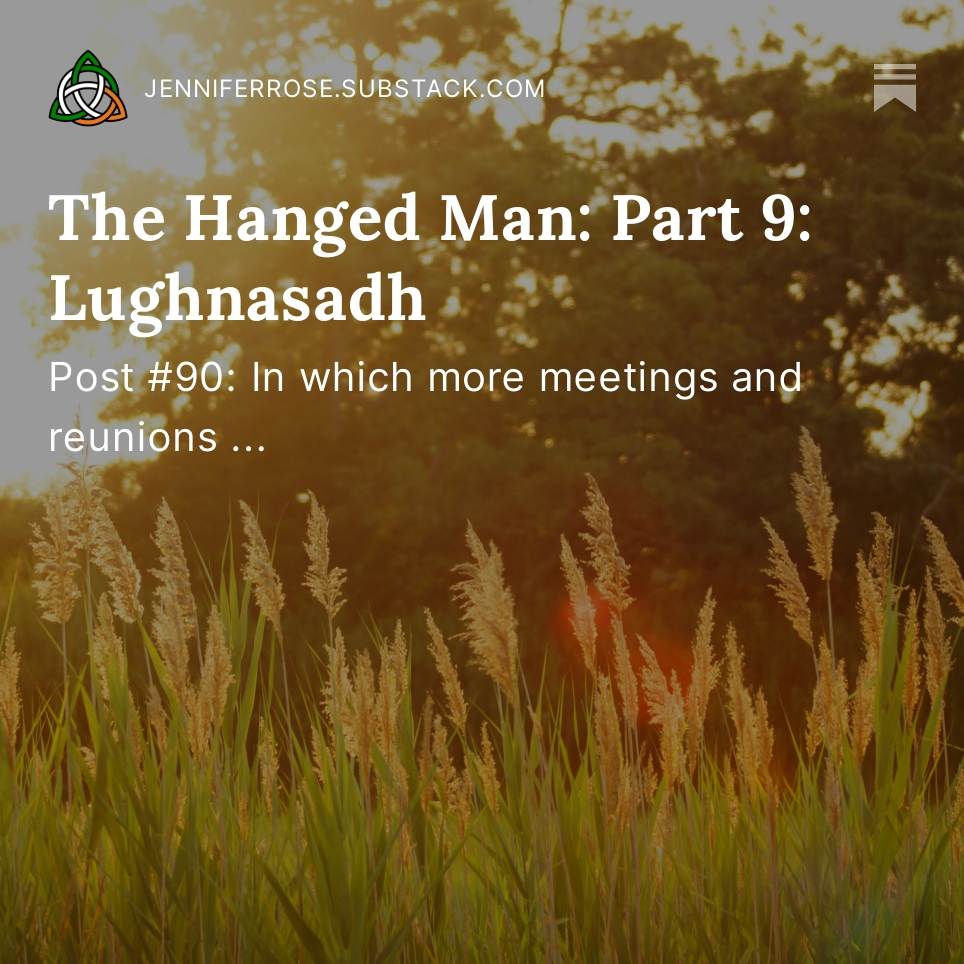
by Jenny Rose | Nov 8, 2018 | A Flourishing Woman, Body
The pool where I work is part of a rehabilitation center, which is part of a local hospital. There are actually two pools. One is a lap pool of about 84 degrees. The other is a large therapy pool, nearly as big as the 4-lane lap pool. The therapy pool is about 94 degrees. The pool patrons are a mix of the public, hospital staff and rehab patients.
As a lifeguard, I spend hours in an elevated chair watching people in the water and moving around on the deck. It delights me to be paid for doing what I naturally do in the world, which is to people watch. In an environment with a consistent air temperature over 80 degrees with more than 50% humidity, all of us — staff, patrons and patients — are necessarily without our usual armor of clothing, make-up and jewelry. We are physically revealed to one another to an unusual degree in a public place.
I’m struck every day by the humility of flesh, the wonder and complexity of our physical being; the almost painful innocence of small children with their rounded, unselfconscious forms; the incredible and paradoxical endurance, resilience and fragility of the human body, and the inexorable truths our unconcealed bodies reveal.
I’m touched by the everyday, patient, humble courage of people whose bodies are ill, injured and aging. I watch people participate in classes: Water walking, water aerobics, arthritis and fibromyalgia in the therapy pool, and swim lessons. I watch couples and families, caregivers and their charges, school groups and special needs groups. People come to lose weight, to rehabilitate after a stroke or cardiac event, to increase their strength and endurance, to recover from surgery or injury. People also come to socialize, to play, and to be inspired and motivated by staff, classes, music and one another.
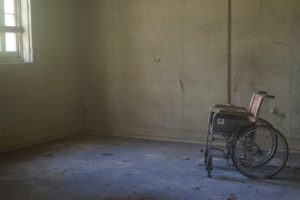
Photo by Doug Maloney on Unsplash
Some folks swim laps. Others water walk and go through exercise routines with buoys, kickboards and weights. They come out of the locker rooms with walkers, canes and wheelchairs. Some need help getting in and out of the pool, or even down to the pool from the parking lot.
For the most part, people who make use of the facility are patient, pleasant and good-natured. Watching them, I wonder at their resilience. What must it be like to be so bent one can only see the floor? How does one cope when the only ambulation possible is to creep along with a walker? The joy and laughter of a wheel-chair bound young person with contorted and twisted limbs like sticks when she’s carried into the therapy pool make me weep.
There’s really no place to hide in the world, at least from ourselves. We all live in a body, and many of us struggle with loving them, including me. We spend an amazing amount of time, money, anguish and effort in disguising our perceived physical defects from the eyes of the world. We tell ourselves nobody can see our shame. No one can see how unlovely or imperfect we really are. No one will ever know.
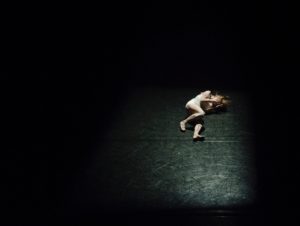
Photo by Hailey Kean on Unsplash
But we know, and our shame and self-loathing poison our lives.
I wonder, as I sit in the chair, what is it about the people who use the pool that enables them to risk physical authenticity? Do they love and accept themselves as they are? If so, how have they developed that ability? Are they unconcerned with what others think of them? Are they like me, and simply resigned to their physical reality, feeling the benefits of using the pool are more important than hiding their appearance, but privately ashamed and embarrassed?
In thinking about this, I realize my own relationship with my body is complicated. On the one hand, I feel affection, loyalty and gratitude. I’ve never aspired to beauty, whatever beauty is. On the other hand, I cringe every time I see a picture of myself, which is not often, as I hate having my picture taken and avoid it whenever possible. I think I cringe because I wish I could protect that vulnerable woman from the eyes and criticism of others. I cringe because my deepest and most private shame is that my physical envelope contains some hidden foulness that makes me unworthy of physical affection and contact. I’m not talking about sex. Sexual attraction and desire are a whole different conversation. I’ve been good enough for sex, but not good enough for consistent loving, nurturing touch. Not good enough to hold.
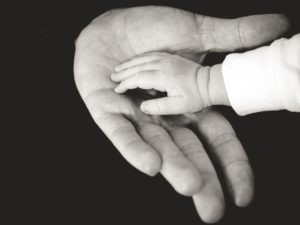
Photo by Liane Metzler on Unsplash
In fact, one of the biggest reasons why I love the water so much is that it touches me.
The shame I feel around this is corrosive and chronic. It’s my intention that it also remain entirely invisible to any onlooker. The pain of this hidden vulnerability of mine enlarges the way I observe others in their bodies. It seems to me we must all have some degree of skin hunger that’s more or less satisfied, depending on our situation. We must all feel some degree of physical isolation and alienation at some point in our lives. Surely every body I see is worthy of care, of love, of touch and nurture, in spite of skin tags, scars, cellulite, bulges and sags, hair distribution or absence, aging, injury and disability, too many or too few pounds.
As I sit on the lifeguard stand, counting heads and scanning the pools, I keep coming back to courage. Courage and humility. The willingness to be seen without the comfort and concealment of clothing. The willingness to be physically authentic and vulnerable. Not a story of courage that will ever be made into a movie, but a kind of daily, humble heroism that touches and inspires me.
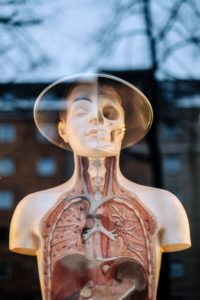
Samuel Zeller on Unsplash
As an observer, it’s effortful to discard childish judgements like “ugly” and “beautiful.” It’s hard not to apply an internalized rating system. I’m tainted by Hollywood, by digitally altered images and by my own private romantic fantasies. Somewhere underneath all the limitations imposed by that conditioning and brainwashing, I glimpse a vast compassionate wisdom encompassing all of us. Life, after all, is beautiful and miraculous. Doing what we can to care for and accept the body we have is an act of courage and strength. Allowing ourselves to be seen and vulnerable takes humility and heroism.
I wonder, somewhat uneasily, if we are no longer able to grasp the beauty inherent in our physical forms. We seem determined to approach the planet’s body, our own and the bodies of others as commodities and resources to plunder, manipulate and then discard when they become boring, worn-out, ill or (at least to our eyes) ugly. Perhaps we’ve lost the ability to appreciate and value everybody in every unique, individual body. Maybe our culture is so injured all we can do now is hate, judge and criticize not only ourselves but others.
Perhaps we’re determined to tear ourselves apart and nothing will stop us.
In the meantime, however, I live in a body, just as you do, and we all have a deeply private and largely invisible relationship with our structure of flesh, blood and bone. My choice is to remain present with the wonder and complexity of the human body, yours, mine and theirs. My choice is to enlarge my compassion and observation until I touch that edge of wisdom that acknowledges beauty and worth in all of physical life, be it human, tree or creature.

Photo by Khoa Pham on Unsplash
All content on this site ©2018
Jennifer Rose
except where otherwise noted
by Jenny Rose | Sep 20, 2018 | A Flourishing Woman, Body

Photo by Anna Dziubinska on Unsplash
I hate to shop. I hate the seductive manipulation inherent in the activity. I’m frustrated by the variation in sizes and disgusted by the ridiculous fashions and prices and the terrible quality. My idea of a great shopping experience is to go to Goodwill and find men’s button-down cotton shirts or buy multiples of Carhartt jeans and shorts on sale. Whenever possible, I shop online, concentrating on sales, outlets and brands that emphasize durability, comfort and easy care rather than shoddy glamour.
One of the drawbacks to shopping online is getting the size right in unfamiliar brands. Regular swimmers know swimming suits don’t last. Sun and pool water take a toll quickly. Suits become thin and transparent and loss their elasticity. The fabric breaks down.
Swimming suits are expensive, and they have to fit well or they’re miserable to wear and impossible to swim seriously in. Teeny-weeny bikinis might look great on the right body poolside, but every woman knows actually swimming in them is another matter, and forget about diving. Men’s comfy jeans cover a multitude of body imperfections, but women’s swimsuits are a different story.
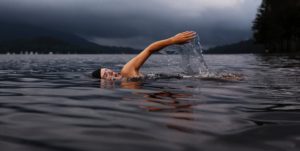
Photo by Todd Quackenbush on Unsplash
All my life I’ve needed a long torso suit, which means fewer choices and more money. When tankinis came out I was delighted because they allow me to wear a regular size, but they’re just as expensive, if not more so, as a standard tank suit. I buy from a big online retailer specializing in all things swimming, and they had a huge Labor Day sale. I was ready. My old suit was beginning to bag, sag and break down.
I shopped for a week, watching prices come down and considering my needs. I finally took the plunge (so to speak) and bought what I wanted. The tankini tops were easy. I’ve worn a 10 in every brand since I was a teenager. No problem. I chose tops that would coordinate with black and got black board shorts for kayaking and black bottoms for swimming. The swim bottoms, however, were an unfamiliar brand. Great price, but unfamiliar brand.
There was a size chart, which I looked at — impatiently. I wanted to make the order and be done with the whole miserable chore. I was pleased to be saving so much money, but I was sick of thinking about swimming suits. I have a sewing tape measure somewhere, but I don’t know exactly where. I had a little construction tape measure in my desk drawer, so I dropped drawers and measured my waist and hips with that. No mirror. Wrong kind of tape measure. Impatient and irritated. According to the size chart, I needed an XL in the swim bottoms. That seemed ridiculous. My ass isn’t that big!
Is it?
Well, I thought, maybe it is. Or maybe the brand I was buying ran really small. My favorite cotton bikini underwear is made in such a way that size 10 is large, not medium. I needed a new suit. I was sick of shopping. I didn’t want the hassle of returning a wrong size, and I didn’t want to refuse to acknowledge the true dimensions of my body out of shame or pride.
So I placed the order and a few days later it arrived. When I unpacked the swim bottoms, they looked huge. I tried them on, over underwear. You couldn’t call them tight, but I thought I could make them work. Everything else was great. I threw away the packing and receipt, discarded my old suit and put my new suit in my swim bag.

Photo by Jeremy Bishop on Unsplash
Getting into a new swimsuit is like trying to stuff yourself into a spandex straight jacket. Getting out of a new suit that’s wet is even worse. I always wind up giggling and feeling as though I’m wrestling with an anaconda. I suited up, showered and got in the pool, feeling spiffy in my new cobalt blue and black swim gear. I put my goggles on and pushed off the wall. My waistband floated up off my waist, the swim bottoms filled up with water and began to slide gently and elegantly off my ass and down my legs. Whoops!
I stood up, took my goggles off, and yanked the bottoms back up. The pool was not busy. Nobody was paying any attention. I was torn between hilarity and frustration. I really wanted to work out, and I hadn’t brought a spare suit. Dammit, I was going to make these work! Maybe if I didn’t push off the wall with my usual vigor it would help. I put my goggles back on, made sure no one was looking, and pushed off the bottom, gently.
The waistband floated off my waist, the swim bottoms filled with water and started to slide off my ass. I kept going, just to see what would happen. I was swimming freestyle, and the bottoms couldn’t quite slide all the way down my legs. Maybe, I thought, I’m not as exposed as it feels like I am. Maybe from above no one can tell how loose they are. Except that I could feel a big bubble of air trapped between me and the fabric. Bubble butt.
Shit!
I tried tucking the hem of the tankini into the bottoms. No dice. The tankini fit just fine, but it’s not long enough to do more than meet the waistband of the bottoms, especially on me.
I was irresistibly reminded of my youngest son, lifted out of his crib in the morning and toddling down the hallway with his usual sunny-natured glee and his sodden diaper hanging to his knees.
Except his diaper had been white and mine was black.
Shit! Shit! Shit!
I longed to tear the stupid bottoms off and throw them on the deck. I’d rather swim naked any day of the week anyway. Seeing as how I was trying to get hired at this particular pool, I thought that might not create a favorable impression.
I climbed out of the pool via the stairs, holding onto the waistband of my bottoms as unobtrusively as possible, and asked a staff member for a safety pin. Surely they had a safety pin, or even a diaper pin somewhere. Things like safety pins, paperclips and rubber bands are in every desk drawer in the world, aren’t they?
Snorting with laughter, because every woman knows the drill of a sudden broken elastic in a waistband or a bra strap, a broken heel or strap on a shoe, a hem that lets go or a stocking that runs at the worst possible time, the lifeguard searched the desk. No pins.
Another lifeguard suggested a rubber band. Good idea!
No rubber bands.
The second lifeguard reached in her pocket and handed me a covered hair elastic. It was even black!
I pulled in the fabric at the waistband, pinched it together as hard as I could and fastened it with the hair elastic. Now the bottoms were much tighter and I had a thick pigtail of fabric poking out at the waistband. It would be invisible in the water.
I returned to the pool, went through the goggle thing and pushed cautiously off the wall.
Hooray! It worked. There was still a little too much slack in the waistband, but they stayed on and didn’t bubble up.

Photo by Chris Kristiansen on Unsplash
In the end, I had a great workout. I returned the hair elastic with thanks when I was finished and then stood in the shower and took several minutes to extricate myself from the tankini top, banging my elbows, writhing, wriggling and squirming. By the time I was free of it, my swim bottoms were around my ankles. No effort required.
Fortunately I have a friend who has a sewing machine. I can sew on a button, mend a simple tear and patch (sort of), but you couldn’t call me a skilled seamstress. I swim again today, and there’s a great big pin in the waistband of my bottoms and a rubber band in my bag, just in case. I also went back to the sale and ordered another pair of bottoms in a smaller size. They were even cheaper.
Here’s what I learned:
- I hate to shop.
- When taking your own measurements, do it with a cloth tape in front of a mirror. Better yet, have someone else do it for the sake of a reality check.
- Don’t throw away packing and receipts until you’ve worn the stupid thing!
- Always carry a couple of safety pins and rubber bands in your swim bag. Consider also Liquid Nails, Super Glue, waterproof duct tape and a staple gun.
- Always carry a spare suit.
- One of the most important keys to life is a sense of humor.
Have I mentioned I loathe shopping?
By the way, I got the job!
All content on this site ©2018
Jennifer Rose
except where otherwise noted
by Jenny Rose | Jun 28, 2018 | A Flourishing Woman, Body
After years of interest, last autumn I finally found a Tai Chi teacher. I approached learning Tai Chi with hopes and expectations about the benefits it could provide, but I was unprepared for the power of the practice and how important it would become in my life.

Photo by Mark So on Unsplash
Tai Chi is a form of Chinese martial art intended to teach defense and support health. It’s a multilayered practice, elegantly complex. Learning the gross motor movements is only the first baby step. One layer is connected to and leads to the next. Tai Chi is not a linear activity to learn from beginner to master, but a dynamic, fluid practice best approached with humility every time. It’s constantly challenging in new ways, depending on what my state of mind, body and spirit is on any given day.
The Tai Chi I practice is called 24 forms, all of which gradually blend into one smooth, flowing whole with practice. The forms have delightful, poetic names like The Crane, Windmills and Clouds.
Tai Chi is about finding one’s center, physically and emotionally, and building on the strength and balance residing there. In order to facilitate this, one crouches slightly with bent knees throughout the whole routine. This is obviously quite challenging, and for some people impossible. However, with proper foot position, body dynamics and a crouched stance, we can immediately feel the solid, stable center at the core of every Tai Chi form. Crouching for long periods of time immediately informs us about the strength of our ankles, knees, hips, hamstrings and quadriceps, information we might not otherwise receive as we move upright through the world.
Crouching assists with balance because it lowers the center of gravity. Many people take up Tai Chi to support balance issues, in fact. Several forms require balancing on one foot or another with the supporting knee bent. This, too, can be unexpectedly challenging. Once again, our body has a story to tell we might not otherwise hear as we move normally. I’ve always been aware I have sloppy posture, but I’ve been habitually lazy about doing much about it. Tai Chi demands I stack my bones on top of one another and tuck in my tailbone. If I don’t do that, I can’t balance. I notice I now move through the rest of my life standing tall, with more grace and confidence and better posture. I don’t slump, crowding my lungs and abdominal organs. I don’t tilt or lean. I know where my pelvis is and I stay over it. My back is happier. I feel better.
Every movement counts in this practice. Each foot is placed just so in order to support a fully centered crouched stance. Shoulders, wrists and elbows stay in line with several of the forms, which necessitates holding arms straight out from the shoulder. My arms ached for months as I built strength, and I’m a strong swimmer who works out in the pool once a week. One form requires placing toes down and heel up, and another the heel down. At times we turn on our heel, and at other times our toe. In one form we turn one foot on the heel and the other on the toe at the same time. Everything about Tai Chi leads me inward on a spiraling journey of deeper focus and mindfulness.

Photo by Ludde Lorentz on Unsplash
It’s amazing to practice over time and begin to feel the forms smoothing out into a cohesive routine with some kind of elegance and grace. Such fun and so rewarding. Then, however, the instructor started to talk to us about our eyes. It turns out every form requires a very specific eye gaze, often on our hand movements. I was doing well with balance, but when I took my gaze off the middle distance and looked at my hand in front of my face, I lost my balance. This was advanced balance. I added in the appropriate eye gaze and started all over again with balance.
Then, the teacher began to talk about breathing. Crap. I hadn’t even thought about my breathing! Breathing is connected to energy, and Tai Chi was originally a practice for working with energy as well as defense. All the forms have to do with pushing, pulling, deflecting or defending. Now that we had some mastery of the physical challenges, we began to work on feeling our field of energy and moving it with our bodies and breath. A push is an exhalation. A pull is an inhalation.
Breathing then leads to pace and rhythm. We practice Tai Chi to meditation music — very slow. Balancing on one leg is not so hard when you do it for two or three seconds. Balancing for sustained periods of time, especially with a bent knee, requires a lot more strength and, well, balance! Every movement takes far more concentration when slowed down. This is one of the few activities I’ve ever done where the goal is to slow down. We seem to be running faster all the time, overstimulated, overscheduled, multitasking, trying to earn more money, perpetually on call via technology. We’re all in pursuit of … something. What? Does anyone ever find it? Is it worth the cost of the chase?
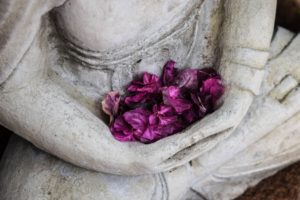
Photo by Chris Ensey on Unsplash
Tai Chi demands we slow down. In that slowness we discover our fatigue, our aches and pains, our half-healed injuries, our distractions and our distress and unmanaged feelings. We remember our center. We recover our balance. We make time to breathe.
Some people call Tai Chi a moving meditation, and I now understand why. When I’m practicing Tai Chi, I’m not doing anything else. When I’m walking or swimming my mind goes right on with whatever it’s busy with. Those activities are good for creative inspiration, prayer and processing feelings. Tai Chi, though, takes me to a deep, restful, quiet place of no thought, focus and present mindfulness, so rich and so empty. It opens the door for awareness, too, of the degree to which I’m captive to distraction. The instant I’m distracted by a sound or a stray thought, I lose my balance and center, I lose my breath, I lose the flow and I don’t know where I am in the forms. I think of myself as fairly focused, but I’m just as susceptible to distraction as anyone else, and I don’t want my life to become an uncontrolled blur of noise and stimulation in which I forget there’s anything but distraction. Tai Chi brings a precious and necessary balance into my days.
All these layers have brought health and healing into my life, but the greatest grace Tai Chi brings me is the opportunity to be in the body. I’m saddened by the ever-more strident body politics in our culture. I don’t remember a time in my life when it seemed so many people were locked in self-hatred and hatred of others based on some kind of physical characteristic. It reflects in our suicide and addiction rates, and it touches each one of us. We no longer honor the sacred feminine and masculine, we have few invitations to fully inhabit ourselves physically, and no one encourages us to honor and respect our physical form as it is.
Just like dance, Tai Chi calls us home to ourselves. My home is not nipped, tucked, plucked, lipo-suctioned, dyed, shaved, made-up, compressed, surgically reconstructed or uplifted. My home is my oldest friend, my most loyal companion, the loyal record keeper and diary of childbirth, breast-feeding, menopause, a lifetime of Colorado sun, slipped kitchen knives and barbed wire fence. My home is lines and wrinkles, lumpy thighs, softened breasts, grey hairs and thinning skin. This amazing, adaptable, resilient, hard-working body is the shelter and haven for my spirit.
I often move a chair aside, open the windows, take up the sheepskin rugs lying on the wide plank floor in my attic space, shut the door at the bottom of the stairs, turn on music and take off my clothes to practice Tai Chi. I like to look down at my bare toes and toe ring on the sloping grey-painted floorboards. I like to glance at my strong knees and make sure they’re in line with my heavy ankles. I like the gentle slope of my belly, cross-hatched with silver stretch marks, under which two children grew into life. I like to stack my bones carefully, tuck in my tailbone and feel the subtle realignment that opens up my center and my balance. I like the clench, pull, stretch and relaxation of my muscles. I like the combination of strength and loosening skin and flesh as I move my arms. I’m grateful for the ability to breath deeply, and the ability to sweat. I relish the air coming in the windows and touching my bared breasts.
We started with a large Tai Chi class, and over the weeks and months people dropped out, one by one. I suppose for some it wasn’t a good fit. For others it wasn’t a priority. Still others were discouraged by their physical limitations, in spite of the fact that the instructor was and is eager to modify the practice to accommodate anyone. One lady had trouble with balance but was unwilling to stand next to a chair for safety and support. Others were ashamed of their weight, their muscle weakness and/or learning a new thing in public. It made me sad. I think many would have benefitted if they could have moved past their shame and self-consciousness, and if they’d been willing to work with their physical reality instead of resenting and arguing with it.
Our Tai Chi group is small now, but we’re good friends. We laugh a lot. We learn from one another. We greet and part with hugs and affection. We enjoy the music; share our distractions, worries, aches and pains and support one another in centering, grounding, calming and mindfulness.
I’m entirely grateful.
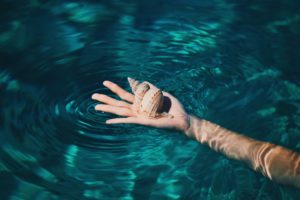
Photo by Biel Morro on Unsplash
All content on this site ©2018
Jennifer Rose
except where otherwise noted
by Jenny Rose | Apr 5, 2018 | A Flourishing Woman, Body, Food
I posted three times about diet and food in 2017. You can find them here, here and here. They are among my most-read posts, and I’ve had enough comments and reads to encourage me to update my experience a year later. I still read everything I see regarding food, nutrition and diet, and I’m still learning what choices give me optimal health and following new science and data.

Photo by freddie marriage on Unsplash
For the record, I’m 54 years old, officially in menopause now, 5 feet 8 inches tall and a steady 140 lbs. I do a minimum of two hours of sweat-producing Tai Chi a week, swim laps for 45-60 minutes without stopping weekly, and walk energetically up and down a steep hill with my partner (about 50 minutes) five days a week. This walk is also sweat-producing. I dance occasionally and take shorter walks and snowshoe excursions several times a week. I go up and down steep flights of stairs all day long, shovel snow and help hump hardwood (heavy!) firewood into the barn. My blood pressure and pulse are both low, and my BMI is exactly where it’s supposed to be. I see a dentist and eye doctor regularly and a medical doctor rarely. I take no prescription medications and I don’t drink or smoke. I sleep 8-9 hours a night.

Photo by Tanja Heffner on Unsplash
In the summer of 2016, as I was slowly eating fewer and fewer plants and more and more meat and animal fats, I had trouble with hair loss. It occurred about six months into my transition to a very low-carb, high-fat diet. As you can imagine, it gave me pause. My hair is one of my few vanities (it misbehaves so gloriously!) and the women in my family have thick, healthy hair. I freaked out.
My first thought was thyroid. I was previously diagnosed as hypothyroid, but I had quit taking my medication when I moved to Maine in 2015 and had no further symptoms. I went to a doctor and had blood drawn. My thyroid levels were normal. Good news, but it didn’t explain my hair loss. At that particular time I was under a great deal of family stress, and the doctor assured me my hair loss was a stress reaction combined with menopause. I wasn’t much comforted, but I couldn’t find another explanation and he was undisturbed, so I decided to give it some time and see what happened.
The stress in my personal life resolved and after three or four weeks so did the hair loss. I didn’t think any more about it until recently, when my partner, who also eats low-carb, high-fat, told me he’d come across a blog post about temporary hair loss being a side effect of transitioning to a ketogenic diet, and it generally occurs around six months into the diet. Hair loss explained. It’s worth noting that since then, my hair is thicker, wilder and curlier than ever, and it grows fast. I need a cut at least every five weeks.

Photo by Amy Reed on Unsplash
In my old life, when I was eating a mostly plant-based diet, I really struggled with constipation. I took fiber supplements and ate loads of fiber-rich foods every day, but it seemed like the more fiber I took, the more trouble I had. I also had a lot of bloating and water retention, which was discouraging. I felt fat, and at the same time I felt depleted.
One of my biggest concerns about trying a low-carb diet was the issue of fiber. Everything I’d ever read told me unequivocally that it’s necessary to eat fiber to maintain a healthy GI tract, and cutting out plant-based food seemed to be going in the opposite direction.
What I discovered was that I still struggled with constipation, but it didn’t get worse. I was surprised, but I still wanted to fix the problem. I did a lot of reading on blogs about eating low or zero carb, and found constipation was a concern for many people. Everything I read pointed to focusing on micronutrients, especially when transitioning to low-carb, high-fat eating. I read a lot about electrolytes: salt, magnesium, calcium and potassium. My plant-based diet was low-salt (I was careful about salt and rarely added it when cooking and baking) and high in magnesium and potassium. My understanding was that salt is very bad for us, and causes high blood pressure, water retention and a myriad of other problems. Further reading informed me salt is a necessary nutrient, and I realized I was getting well below the recommended levels of salt, potassium and magnesium in my diet of meat and fat.

Photo by Jason Tuinstra on Unsplash
I began to supplement magnesium and potassium, and I stopped restricting salt (which I’ve always loved). I also began making sure I drink at least 3 liters of water a day, more when it’s hot and humid. The other thing I read about consistently, and this was the hardest for me, was that one needs to eat at least a pound of meat a day, and many people aim for two. That’s a lot of meat!
When I implemented all this, my constipation went away. My blood pressure and water retention did not increase with increased salt. I never have bloating. If I have trouble now, it’s because I’ve been too sedentary, not drinking or eating enough, or I forgot my usual supplements.
When I began eating low-carb, high-fat, I also started having severe leg and foot cramps, which I’d never had before. They weren’t like my chronic pain and spasm, but in the middle of the night, without warning, my calf or foot would cramp, waking me in a hurry and making me writhe for a few seconds before it relaxed. I was concerned this was a sign that eating this way was as insane and unhealthy as most people say it is and I was starving my body of what it needed, but this, too, turned out to be a function of imbalanced electrolytes and under hydration. I haven’t had any kind of cramp since last year.
In retrospect, I wonder if both my chronic pain and spasm and my constipation had a lot to do with imbalanced electrolytes all along. It may be I’ve been chronically sodium deficient. I also believe I’ve been chronically under hydrated for most of my life. I have to really pay attention in order to get three plus liters of water a day, and I lived in Colorado, which is terribly dry, before I came to Maine. Obviously, staying well hydrated is essential to healthy bowel habits.
Another problem I had was debilitating migraine headaches that lasted for at least 24 hours and made it impossible to function. Photophobia, phonophobia, neuralgia and pounding pain had me in a dark room with an ice pack. For two or three years I had them once a month, right at the full moon. As I started eating meat and fat and reducing carbs, they gradually diminished in intensity, frequency and length. I’ve had one so far this year, and I was able to function all the way through it, albeit with discomfort.
So what, exactly, does my current diet look like?
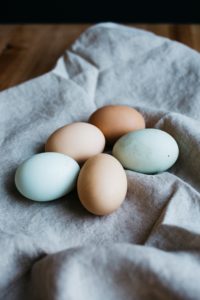
Photo by Rachael Gorjestani on Unsplash
I eat three thick slices of bacon and two sausage links with four to five buttered eggs every morning. It’s always delicious and I’m not even close to bored eating it daily. I also drink my first liter of water in unsweetened green tea and just plain water with breakfast. Every other day I put a spoonful of fresh farm cream cheese with garlic and herbs on the eggs. We usually eat before 8:00 a.m.
I don’t think about food again until around 3:00 p.m. I write for three or four hours, exercise, do housework, run errands, etc. I usually drink a couple more cups of herbal tea and I drink at least another liter of water. Sometime mid afternoon I’ll feel hungry. My partner makes a beef stew to die for, but we don’t always have that. We always have ground beef, however, and last fall we saved money and bought half a locally-raised cow, butchered and packaged to our specifications. The meat is grass-fed and very lean. I’m sure this is what most people want, but we find it too lean. Because of that, I make a burger patty or crumble and cook the beef in the frying pan from breakfast in order to take advantage of the bacon and sausage fat. The lean ground beef soaks up the fat pretty well, especially if I just crumble and cook it, which takes about 2 minutes. I aim to cook at least 3/4 of a pound of burger.
I find this extremely filling and satisfying. I drink a lot of water with it. Now and then I spoon garlic and herb farm cheese on top. If I’m really starving or feel extra depleted, I bake a half a sweet potato or white potato, anoint it with lots of butter and fresh farm sour cream. I don’t eat any kind of carb without eating fat and meat first.
I also buy unsweetened, full-fat farm yoghurt, and sometimes after my afternoon meal I’ll eat a couple big spoonfuls of that. When there is beef stew, I occasionally like to have a half a thin slice of locally baked wheat bread, liberally buttered, with the gravy. I love ice cream, and about once a week I eat a small bowl of hard ice cream, but only after a good meal of meat and fat. If we buy ice cream in town, I get a child’s serving in a bowl. Cones are just empty carbs, and they make me hurt. My partner likes banana bread, and he occasionally bakes a very low-sugar version. Sometimes I’ll eat a half a thin slice, thickly buttered, as a treat after my afternoon meal.
I have a tendency to react badly to nuts, but I love peanut butter, and we buy nothing-added-but-salt peanut butter from East Wind in bulk. Once a week I eat a spoonful of that on a small square of buttered bread.
Oddly, I’ve discovered eating one spoonful of ice cream a day causes far more problems than having a small serving once a week. For me, there seems to be a cumulative effect in terms of carbs. Now and then I splurge on a carb, just for fun, and if I’ve eaten meat and fat first I can get away with it without too many consequences. If I squirt a little catsup on my burger three days in a row, though, I’m going to start to have pain that limits my activity level and sleep. Commercial catsup, for some stupid reason, is sweetened.
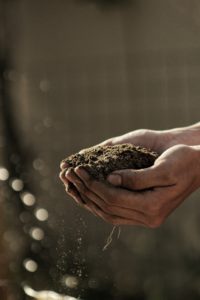
Photo by Gabriel Jimenez on Unsplash
Since I last wrote about food, I’ve done a lot of reading on permaculture, holistic food production, and land management. Please see my Resource page for links. What I’ve learned is that monocropping is biocide. Large-scale animal production can be equally catastrophic for the land and environment. What we know now is that a healthy complex system (i.e., Planet Earth, left undisturbed) contains an essential mix of plants, fungi, microorganisms, insects and animals. Earth is evolved for such communities, and we will destroy the planet if we don’t figure out how to emulate, nurture, protect and participate in such systems. All life will starve to death.
The most extraordinary thing about eating this way, and the hardest part to communicate to someone who doesn’t, is the level of hunger satisfaction. Previously, I was always snacking. A piece of fruit, a couple of pieces of toast, a salad, a smoothie. I was always hungry, and I was always ashamed of it. My shame caused me to withhold food from myself, which only made my cravings worse. My weight, mood and energy fluctuated wildly. My sleep was bad. I had constant pain. I was always thinking about food, one way or another.
It’s hard to express how different it is to eat a big breakfast and walk away feeling really satisfied and full until six or seven hours later. No craving. No shame. No snacking. No sense of deprivation. No counting calories or weighing portions. Then, another big meal, the evening routine and bedtime, satisfied and satiated. When I’m hungry, I eat. I don’t care what time it is or what else is going on. When I’m full, I stop eating. That’s it.

Photo by Erda Estremera on Unsplash
The same level of satisfaction applies to drinking water. We drink filtered water from our old hand-dug well, and I never thought just plain water could give me so much pleasure. You couldn’t pay me to drink soda or sweet tea or any of the things I used to drink. When I’m thirsty, I want water, lovely, fresh, cool, clean water. I’m never bored with it. I never want anything else. It satisfies me in a way that’s so deep it’s almost sensual.
I never feel deprived.
It’s worth noting that the absolutely most satisfying meat is beef. I eat some chicken and, occasionally, turkey, but I have to eat two or three times as much in order to get the same level of satiation, and those meats are less fatty than beef. Pork is good because it’s high-fat, and we hope to be able to buy a half a pig in the future from local farmers.
Sometimes, if I’ve been working unusually hard physically or am unusually emotionally upset, I’ll need a fast snack. In this case, hard-boiled eggs are portable, quick and healthy. Every couple of months I buy a plain ham, unsweetened, smoked, or otherwise manipulated, as fatty as I can find. I thin slice it and pack it into small baggies, which I throw in the freezer until wanted. This provides a quick, high-fat, high-salt, tasty snack I can eat on the run or in a hurry. If I’m going to visit a friend and have a cup of tea or a chat, I eat a little ham so I can have a cracker or cookie with my friend without paying for it in pain.
We have the great good fortune to be able to buy food from a farm. I no longer buy commercial milk, cheese, yoghurt, sour cream or eggs. Nothing compares to food that hasn’t left the farm until you take it home. It puts money back into the local community, fosters small-scale farmers who are working holistically with animals and plants (and they work day and night, let me assure you), and it allows me to know exactly where my food is coming from and how it’s being handled. It’s also fresh and far more delicious than anything available in the grocery store.
I’ve seen blogs and posts from people who claim to have tried a low or zero-carb, high-fat diet and say it “doesn’t work.” I’m not sure what “doesn’t work” means, exactly, but I always long to ask a lot of nosey questions. First, what was the goal? Why did they try it? Secondly, how long did they stick to it? Thirdly, did they really commit to it? Did they suspend their soda habit, stop sweetening their coffee and ditch the “healthy” granola bars? Did they eat meat and animal fat and drink water and nothing else? Lastly, do they smoke tobacco or drink? All alcohol is carbs. Do they take any prescription drugs or use recreational drugs?
Another thing I’ve heard is that eating this way is unmanageable socially. I don’t buy that. If you’re trying to change the way you eat in order to feel better and improve your health and your buddies at the bar give you a bad time for refusing nachos and cheese fries, grow a pair and tell them to back off! Better yet, get them to join you! Do a two-week challenge and bet on who will lose the most weight. True friends will support friends in maintaining health. If you can pack a sandwich for lunch, you can pack fatty ham, hard boiled eggs, and a container of full-fat unsweetened yoghurt. If your only option is fast food, buy a couple of burgers and ditch the buns and condiments. If you want to eat this way, you can. Nobody cares. Nobody’s really paying attention. They’re too busy with their own food preoccupations! Pot luck? Take a tray of cold cuts or deviled eggs. We go out to eat a couple of times a week and enjoy eggs and sausage, meatloaf, pot roast and chopped sirloin. Hold the bread, hold the side salad!
Eating in this way has transformed my life and my health. Shopping is easy, infrequent and fast. Every ten days or so I visit my friend’s farm, buy eight dozen eggs, cheese, sour cream and/or yoghurt (according to need), chat and exchange a hug. I spend a half hour in the kitchen making breakfast, doing dishes, giving the cat fresh water, looking out the windows, watching the birds and thinking about the day ahead. My afternoon meal is either already made (stew) or takes two or three minutes to cook in the breakfast frying pain. I don’t meal plan. We know exactly what we need to budget to eat well. I don’t need a lot of gear and gadgets or cupboard space. The refrigerator is not overflowing with who-knows-what leftovers and outdated food. Our collection of plastic Tupperware containers is virtually unused (which is good, because there are mice in that particular cupboard!). We don’t produce much trash, because we don’t buy cans, bags and boxes. We recycle all our egg cartons, plastic and aluminum. We compost egg shells, tea bags, coffee grounds, and any small amount of vegetable matter. Meat and bacon grease is also perfectly suitable for compost, managed properly. We know farmers who have buried a whole dead goat in the center of their compost pile with no smell and no problem.
I don’t diet. I eat food — joyously, effortlessly, with great satisfaction and pleasure. I drink water with a deep sense of gratitude that I have clean water to drink. I feel healthy, happy, energetic and filled with vitality. My body is my friend and ally, and I think it’s miraculously lovely.
Diet is a personal choice. I suspect different bodies have different requirements. Some people can’t eat eggs or dairy. Some are particularly sensitive to the herbicides in our grains. I also suspect that a lot of the current mainstream information and advice about food is skewed and misleading. I encourage everyone to research for themselves. A sampling of the links I’ve provided in these posts and on my Resource page may provide you with new information and data. Ultimately, the choice is yours, and yours alone. If you’re happy with your physical and mental health, your relationship to food and your body, and you have no need to take over-the-counter or prescription medication, you obviously have figured out what works for you. If not, it’s important to understand you’re not alone and not everyone (not even all doctors) is in agreement about diet.
As for me, I will never go back to a plant-based diet, chronic pain and spasm, constipation, migraines, hypothyroidism, anxiety and depression, insomnia and weight problems. I’m a carnivore, and I eat meat and animal fat with great relish.

Photo by Lukas Budimaier on Unsplash
All content on this site ©2018
Jennifer Rose
except where otherwise noted



























